找出神经免疫学空白的系统方法:以 TNF-α 和恐惧学习障碍为例
IF 8.8
2区 医学
Q1 IMMUNOLOGY
引用次数: 0
摘要
背景:一些神经退行性疾病和神经精神疾病的病理生理学与免疫系统的改变有关。然而,由于神经免疫相互作用非常复杂,人们往往不清楚免疫系统是如何具体影响这些疾病的。在本文中,我们将毒理学中的不良后果途径(AOP)方法调整后引入神经免疫学领域。本文以 TNF-α 对恐惧学习障碍的影响为例,展示了 AOP 方法如何帮助识别神经免疫疾病病理生理学中的知识空白和关键步骤:AOP 的构建分为五个步骤。首先,明确而具体地提出不良后果。其次,在 Medline 数据库中进行初步文献检索,确定分子起始事件与不良后果之间的联系。第三,进行系统的文献检索,我们发现了 95 篇相关文章。第四,确定了主要的生物学过程和相关的关键事件。第五,确定了关键事件之间的联系,并构建了 AOP 网络:结果:我们发现了 TNF-α 影响恐惧学习的三个途径。首先,TNF-α受体激活会增加NF-κB水平,从而增加氧化应激水平并降低谷氨酸转运体的活性。这就改变了突触的可塑性,而突触的可塑性与恐惧的获得、巩固和消除有关。其次,TNF-α受体的激活会增加血清素转运体的表达和能力,而血清素转运体与恐惧的获得、表达和消除受损有关。第三,TNF-α受体1激活可诱导坏死,导致神经炎症,而神经炎症与恐惧学习障碍有关:为了在神经免疫学中成功应用 AOP 方法,我们建议更精确地定义不良后果,在各种生物过程的关键事件之间建立更强的联系,纳入前馈和反馈回路,并在后面的关键事件中确定更多的机理知识。需要进行这些调整,以绘制神经免疫学领域的复杂过程图,并找出知识差距。本文章由计算机程序翻译,如有差异,请以英文原文为准。
A systematic approach to identify gaps in neuroimmunology: TNF-α and fear learning deficits, a worked example
Background
The pathophysiology of several neurodegenerative and neuropsychiatric disorders is linked to an altered immune system. However, it is often unclear how the immune system specifically affects these disorders since neuroimmune interactions are very complex. In this paper, we introduce an adjusted version of the adverse outcome pathway (AOP) approach from toxicology to the field of neuroimmunology. A review of the effect of TNF-α on fear learning deficits is used as a worked example to demonstrate how an AOP approach can help identify gaps of knowledge and crucial steps in the pathophysiology of neuroimmunological disorders.
Methods
The AOP was constructed in five steps. First, the adverse outcome was formulated clearly and specifically. Second, the link between the molecular initiating event and the adverse outcome was established with a preliminary literature search in the Medline database. Third, a systematic literature search was performed in which we identified 95 relevant articles. Fourth, the main biological processes and relevant key events were identified. Fifth, the links between key events were determined and an AOP network was constructed.
Results
We identified three pathways through which TNF-α may affect fear learning. First, TNF-α receptor activation increases NF-κB levels which increases oxidative stress levels and reduces the activity of glutamate transporters. This alters the synaptic plasticity which is associated with impaired fear acquisition, consolidation, and fear extinction. Second, activation of TNF-α receptors increases the expression and capacity of the serotonin transporter which is linked to impaired fear acquisition, expression, and extinction. Third, TNF-α receptor 1 activation can induce necroptosis, leading to neuroinflammation which is linked to fear learning deficits.
Conclusion
To successfully apply the AOP approach in neuroimmunology we recommend defining adverse outcomes more precisely, establishing stronger connections between key events from various biological processes, incorporating feedforward and feedback loops, and identifying more mechanistic knowledge in later key events. These adjustments are needed to map the complex processes within the field of neuroimmunology and to identify gaps of knowledge.
求助全文
通过发布文献求助,成功后即可免费获取论文全文。
去求助
来源期刊
CiteScore
29.60
自引率
2.00%
发文量
290
审稿时长
28 days
期刊介绍:
Established in 1987, Brain, Behavior, and Immunity proudly serves as the official journal of the Psychoneuroimmunology Research Society (PNIRS). This pioneering journal is dedicated to publishing peer-reviewed basic, experimental, and clinical studies that explore the intricate interactions among behavioral, neural, endocrine, and immune systems in both humans and animals.
As an international and interdisciplinary platform, Brain, Behavior, and Immunity focuses on original research spanning neuroscience, immunology, integrative physiology, behavioral biology, psychiatry, psychology, and clinical medicine. The journal is inclusive of research conducted at various levels, including molecular, cellular, social, and whole organism perspectives. With a commitment to efficiency, the journal facilitates online submission and review, ensuring timely publication of experimental results. Manuscripts typically undergo peer review and are returned to authors within 30 days of submission. It's worth noting that Brain, Behavior, and Immunity, published eight times a year, does not impose submission fees or page charges, fostering an open and accessible platform for scientific discourse.

 求助内容:
求助内容: 应助结果提醒方式:
应助结果提醒方式:


